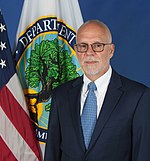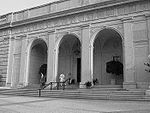U.S. Department of Agriculture Cotton Annex
Cotton industry in the United StatesGovernment buildings completed in 1937Government buildings on the National Register of Historic Places in Washington, D.C.Stripped Classical architecture in the United StatesUnited States Department of Agriculture facilities

The U.S. Department of Agriculture Cotton Annex is an office building located at 300 12th Street SW in Washington, D.C. The size of the building has been variously given at 89,000 square feet and 118,000 square feet.
Excerpt from the Wikipedia article U.S. Department of Agriculture Cotton Annex (License: CC BY-SA 3.0, Authors, Images).U.S. Department of Agriculture Cotton Annex
12th Street Southwest, Washington
Geographical coordinates (GPS) Address Nearby Places Show on map
Geographical coordinates (GPS)
| Latitude | Longitude |
|---|---|
| N 38.885555555556 ° | E -77.027777777778 ° |
Address
Dept of Agriculture Cotton Annex
12th Street Southwest
20013 Washington
District of Columbia, United States
Open on Google Maps








